Top Indie-Folk, Americana Spotify playlists and trigger cities [Part 2]
We are back with part 2 on trigger cities and the importance of different types of Spotify playlists for Indie Folk and Americana artists.
A guest post by Terry Tompkins, Ulf Oesterle, Charles Alexander of How Music Charts.
Editor’s Note: Terry Tompkins, Ulf Oesterle, and Charles Alexander are longtime music industry veterans, educators, and researchers. You can read Part 1 of this series here and find the full findings of this two-part series in the Music and Entertainment Industry Educators Association (MEIEA) Journal.
In Part 1 of this series, we explored 11 Indie Folk and Americana artists’ (the “Artists”) presence on Spotify, the single most impactful performance driver for the artists in this study (accounting for 87 percent of total streams). In Part 2, we examine the geographic profile of listeners and the potential for an alternate set of Trigger Cities by evaluating the results of a directed ad campaign to Spotify through Facebook and Instagram.
Geographic Profile of the Artists’ Listeners
A few notable cities emerged when reviewing the total monthly listeners on Spotify for the Artists: Denver, Colorado (No. 1); Charlotte, North Carolina (No. 11); and Houston, Texas (No. 14).
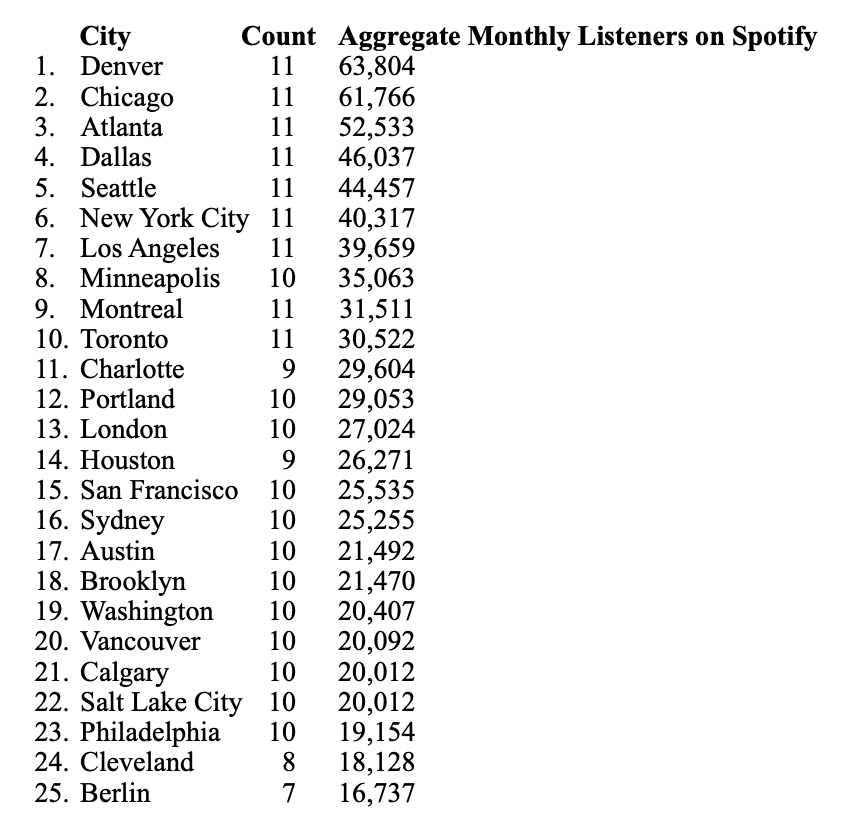
In analyzing the total monthly listeners compared to the corresponding city population, the Artists’ reach over-indexed in Seattle, Minneapolis, Denver, Salt Lake City, and Atlanta.
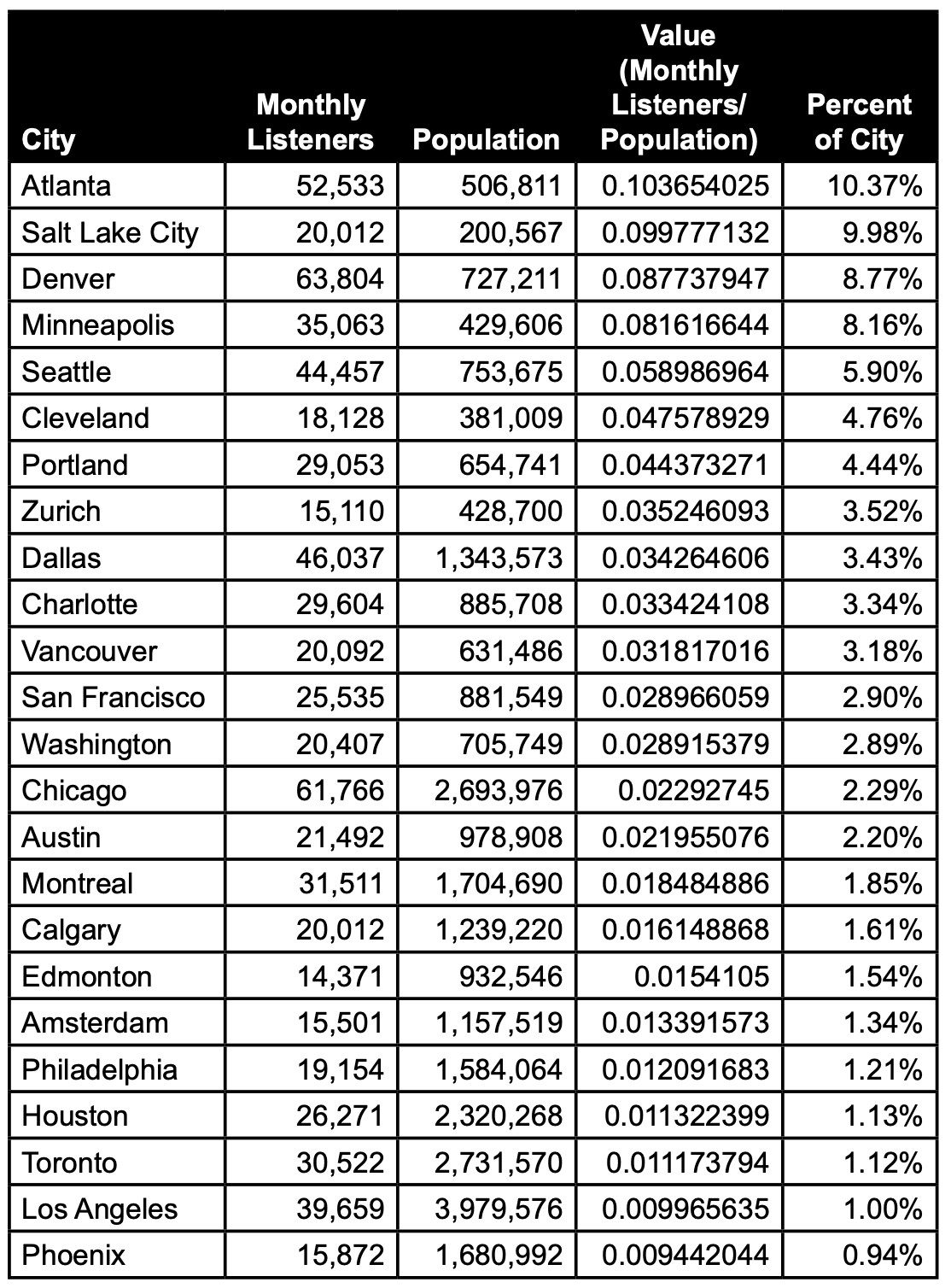
Looking at the data across Chartmetric’s database of 2.5K Indie Folk and Americana artists, the Top 100 cities drive consumption with a 96 percent share of listeners, and the Top 50 cities comprise 83 percent of monthly listeners. Therefore, one would assume that marketing beyond those 50 or 100 cities would produce diminishing returns. However, as described below, the results of the authors’ advertising campaign demonstrate that global opportunities exist for Indie Folk and Americana artists outside of the Top 50 or Top 100 streaming markets.
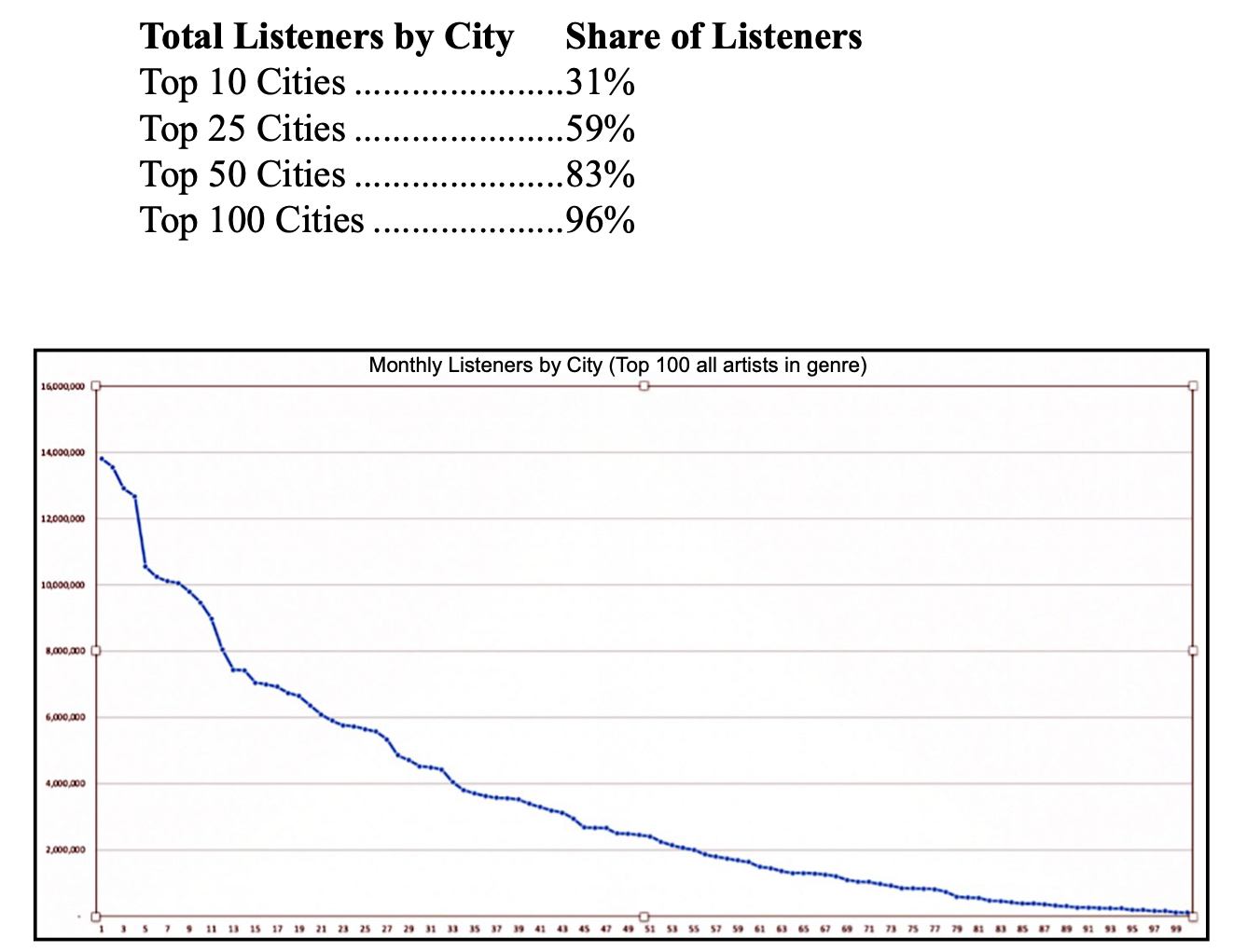
Trigger Cities Advertising Campaign: Method and Results
We ran a comprehensive advertising campaign on Facebook and Instagram to determine whether the Artists could be introduced to new audiences in the global music marketplace. The campaign ran for 29 days via Facebook and Instagram feed ads directed to the Artists’ Spotify playlists. The playlists were curated by Spotify as “This Is” discography playlists (see Part 1) or curated by an Artist as “This Is” or “Favorite Songs” via user-generated playlists on the Artist’s profile.
Each playlist included a minimum of 30 songs and the call to action for consumers was to “follow” the Artist’s playlist and/or “stream” the featured song. The ads consisted of a 15-second video featuring the Artist’s music and image and were delivered on Facebook’s Ads Manager and Found.ee. The advertising budget ranged from $20-30 per day, per Artist, and it was equally distributed between Facebook and Instagram for all Artists. The campaign concluded on June 19, 2021.
Ad Targeting: Geographic Regions
The geographic regions targeted in the ad campaign came from the Artists’ Spotify for Artists dashboard and Chartmetric’s database of 2.5K Indie Folk and Americana artists, and included North America, Australia, and Western Europe as the primary regions for streaming activity on Spotify. The authors then expanded this geographic radius to explore advertising audiences in additional regions based on Spotify’s global population of users.
Ad Targeting: Related Artists
For each specific Artist, we developed a distinct list of targeted artists known as “related artists” to reach Indie Folk and Americana music audiences. The ads targeted fans of these related artists on Facebook and Instagram in the selected geographic regions. Related artists included The Lumineers, The Head and the Heart, Gregory Alan Isakov, The Avett Brothers, Mumford & Sons, Lord Huron, The Paper Kites, Rayland Baxter, Fleet Foxes, The Shins, First Aid Kit, Andrew Bird, Father John Misty, Band of Horses, Mandolin Orange, Sharon Van Etten, Phoebe Bridgers, Dawes, Lake Street Dive, and others.
Ad Targeting: Age Demographic
The distribution of age from Spotify for Artists data displayed a broad range of listeners aged 18-59 years old (see chart below) evenly weighted between male and female. Therefore, the initial ad campaign targeted a diverse range of ages to reach a broad audience of Spotify users who listened to Indie Folk and Americana music. The ads were directed to a landing page that was embedded with a pixel to provide insights regarding demographic and geographic profiles. After measuring reach and impressions from the initial campaign, the ads were refined to target users who watched the video or clicked on the ad previously and expand the initial interest audience.

Advertising Campaign Results
Advertisements were served to audiences in 74 countries reaching 1,617,313 impressions and 23,591 total ad engagements (i.e., clicks) with a 1.46 percent click through rate (CTR). A total of 80 percent of ad clicks emanated from the Top 10 returning countries, all based outside of North America and Australia, including Brazil, Philippines, and Mexico, all of which Chartmetric has identified as countries with a high concentration of Trigger Cities. Looking beyond these territories, Algeria, Egypt, Tunisia, and Vietnam appeared in the Artists’ Top 10 as well.
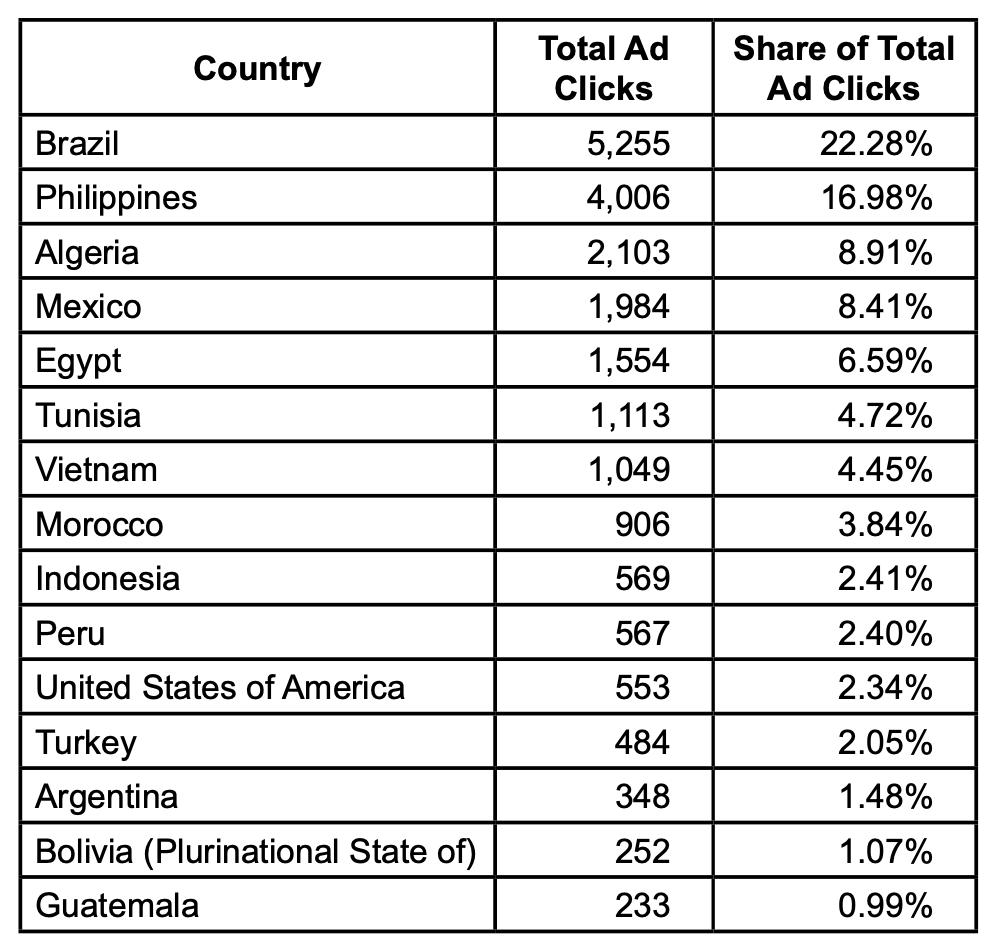
When assessing streaming activity for the Artists on their Spotify for Artists dashboards, several outlying territories emerged that were not listed in the Top 10 ad markets, including Japan, Bolivia, Finland, and Spain, in addition to Trigger City regions like Brazil, Indonesia, Turkey, and Australia.
Developing Artists averaged 2,986 clicks during the campaign, while mid-level Artists (1,614 clicks) and established Artists (1,729 clicks) experienced similar engagement. Advertising clearly benefited the developing Artists in this study, as the playing field was leveled in regions outside of the United States.
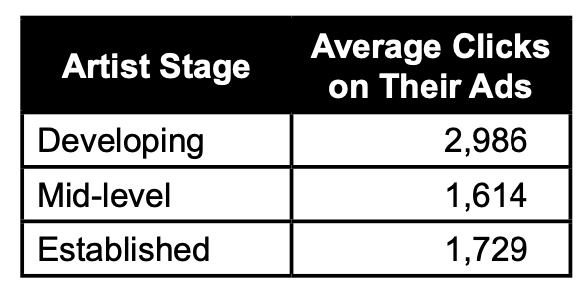
Playlist Follower Growth
Playlist followers grew by an average of 349 percent for all Artists. Developing Artists benefited most significantly from the ad campaign. The average playlist follower growth was 736 percent for developing Artists. Mid-level Artists grew their playlists at an average of about 169 percent, and established Artists experienced the lowest growth (72 percent).
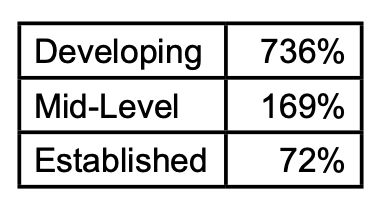
Results indicated that developing Artists received the highest save rate on Spotify for songs used in the campaign, with an average 25 percent save rate, well above the 3-8 percent industry average save rate range. Mid-level (8 percent) and established (3 percent) Artists’ save rates fell within industry averages.
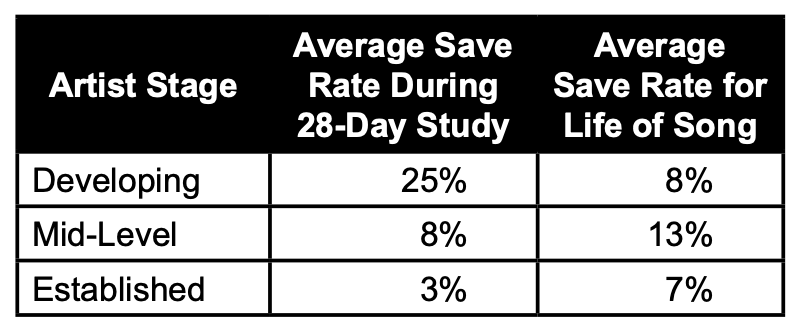
Takeaways
Our research suggests artists from different genres may have a unique set of Trigger Cities to consider when targeting audiences globally. This study realized several potential regions for Indie Folk and Americana audiences to consider not cited in Chartmetric’s original Trigger Cities study. Paid ads on social media had the greatest impact on developing Artists, supporting Chartmetric’s theory that new markets and audiences are inclined to engage with emerging talent. With the low barrier to entry in the music industry and the growth of streaming as a means to engage with listeners, artists from each genre need to consider their own subset of Trigger Cities to build global audiences.
Read “Indie Folk & Americana Triggers: An Analysis of Streaming Music, Audience Behavior, and Global Opportunity” in full here.
About the Authors
Terry Tompkins is Assistant Professor and Program Coordinator of the Music Business Program at Hofstra University. Tompkins has been a professional and professor in the music industry for the past 25 years working as an artist manager, talent buyer, journalist, record label president, festival organizer, and A&R Rep. Tompkins is a board member of the Music and Entertainment Educators Association (MEIEA) and his area of expertise as a researcher includes analytics, experiential learning, the concert industry, and social media. He has been published in the Music and Entertainment Educators Association Journal, The International Journal of Music Business Research, and the Journal of Instructional Pedagogies.
Dr. Ulf Oesterle is Assistant Professor at the Bandier Program at Syracuse University teaching recorded music, live music, social media strategy, and data within the music business. He has operated a small record label, an artist management company and been the host of a commercial specialty radio show. Outside of campus, Dr. Oesterle currently sits on the board of the Music and Entertainment Educators Association (MEIEA), contributes to educational endeavors for Show Makers, speaks at conferences regularly, and consults about TikTok strategy while managing his own creator presence on the platform.
Charles Alexander is a digital music & media strategist and music technology educator. He is the founder and owner of Systemic, a label services company specializing in streaming marketing and strategy, and Outside The Box Music, a management and digital services company. He has been a speaker and panelist at SXSW, Music Biz, CD Baby DIY Conference, Leadership Music’s Digital Summit, Americana Music Conference, and The International Folk Alliance and has contributed to the national discussion on SOPA, the online piracy bill.